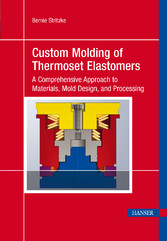Bernie Stritzke
Custom Molding of Thermoset Elastomers
A Comprehensive Approach to Materials, Mold Design, and Processing
Acknowledgment
6
Preface
8
Contents
10
1 Introduction to Thermoset Elastomer Chemistry
16
1.1 Chemistry Overview
16
1.2 Polymerization
18
1.3 Thermoplastic Polymers
19
1.4 Thermoset Polymers
20
1.5 Organic and Silicone Elastomers
20
1.6 Cure Rates
22
1.7 Conclusion
22
References
22
2 Compounding, Mixing and Equipment
24
2.1 Introduction
24
2.2 Compounding
24
2.3 Mixing
25
2.3.1 TSE Compound Batch Release Tests
29
2.4 Silicone
29
2.5 Conclusion
30
References
30
3 Materials
32
3.1 Natural Rubber (NR)
32
3.2 Synthetic Polyisoprene (IR) [2]
33
3.3 Styrene-Butadiene (SBR) [3]
33
3.4 Polybutadiene (BR) [4]
34
3.5 Butyl (IIR) [5]
34
3.6 Ethylene-Propylene-Diene (EPDM)
35
3.7 Nitrile (NBR) [7]
35
3.8 Polyacrylic (ACM)
36
3.9 Ethylene Acrylic (AEM)
36
3.10 Silicone (MQ, VMQ, and PMQ)
36
3.11 Fluoroelastomer (FKM) [14]
37
3.12 Polyurethane (AU and EU) [15]
38
3.13 Epichlorohydrin (CO and ECO)
38
3.14 Conclusion
38
References
38
4 Product Design
40
4.1 Introduction
40
4.2 Material
40
4.2.1 ASTM Classification System for Elastomeric Materials
42
4.3 Design
43
4.3.1 Tolerances
45
4.3.2 Material Shrinkage
47
4.4 Conclusion
48
References
48
5 Material Testing for TSE
50
5.1 Introduction
50
5.2 Physical and Chemical Properties Tests
50
5.2.1 Tensile Testing
51
5.2.2 Compression Set
52
5.2.3 Durometer
52
5.3 Heat Aging
53
5.3.1 Accelerated Aging
53
5.4 Rubber Property – Vulcanization Using Oscillating Disk Cure
53
5.5 Fluid Resistance
54
5.6 State-of-Cure
55
5.7 Conclusion
56
6 Polymer Flow
58
6.1 Viscosity
58
6.2 Elasticity [5]
59
6.3 Plasticity [6]
60
6.4 Rheology
60
6.4.1 Thermoplastic Fluid Properties
61
6.4.2 TSE Fluid Properties
63
6.5 Shear Thinning
64
6.6 Rotational Viscometers
65
6.7 Oscillating Rheometers
67
6.8 Conclusion
68
References
68
7 Molding Methods and Related Topics
70
7.1 Introduction
70
7.2 Choosing a Process
70
7.3 Book Mold
73
7.4 Bolt-In
74
7.5 Shuttling
74
7.5.1 Double Shuttle
74
7.5.2 Single Plate Shuttle
76
7.6 Rotary Molding
77
7.7 Core Bar
80
7.8 Mold Construction
81
7.8.1 Cavitation
82
7.9 Article Removal/Ejection
83
7.10 Mold Cavity Finish
83
7.11 Heaters
84
7.11.1 Heater Calculation [4]
85
7.11.2 Running
87
7.11.3 Conclusion
87
7.12 Heat Transfer
87
7.13 Insulation
89
7.14 Vacuum
89
7.15 Release Aids
93
7.15.1 Mold Lubes
93
7.15.2 Mold Plating
93
7.16 Mold Cleaning
95
7.16.1 Plastic Media Blast
95
7.16.2 Ultrasonic Cleaners
96
7.16.3 Ice Blast
96
7.17 Conclusion
96
References
97
8 Compression Molding
98
8.1 Compression Presses
98
8.2 Preps
99
8.3 Operator Influence and Automation
100
8.4 Material Flow
101
8.4.1 Trapped Air
102
8.4.2 Molecular Orientation
102
8.5 Mold Construction
102
8.5.1 Disk Springs
103
8.5.2 Relative Cost
104
8.6 Pressure
104
8.7 Backrind
105
8.8 Mold Cleaning
105
8.9 Article Removal/Ejection
105
8.10 Compression Mold and Die-Cut
106
8.11 Dual Acting Spring Mechanism Compression Molding
107
8.11.1 Prep Compensating Mechanism
110
8.11.2 Secondary Trim
111
8.12 Conclusion
112
References
113
9 Transfer Molding
114
9.1 Self-Contained Pot
114
9.2 Bottomless Pot Transfer
115
9.3 Transfer Press
117
9.4 Flashless Transfer Molding
118
9.4.1 Split-Top Inserts
120
9.4.2 Vents
121
9.4.3 Trapped Air
122
9.4.4 Sprues/Gates
122
9.4.5 Knit Lines
123
9.4.6 Ring Gates
124
9.4.7 Mold Construction
124
9.4.8 Transfer Pressure
124
9.5 Mold Cleaning
125
9.6 Wasteless Transfer
126
9.6.1 Equalizing Platen
128
9.7 Conclusion
128
References
129
10 Injection Molding
130
10.1 Injection Unit
131
10.1.1 First In – First Out (FIFO)
133
10.1.2 Plunger Unit
134
10.1.3 Injection Controls
134
10.1.4 Injection Location
135
10.1.5 Material Feed – Stripped
136
10.1.6 Material Feed – Stuffer
136
10.2 Materials
136
10.3 Automation
136
10.4 Mold Construction
139
10.5 Molding Defects
139
10.5.1 Scorch
139
10.5.2 Cured Stock
140
10.5.3 Adhesive Wash
140
10.6 Injection Transfer
140
10.7 Injection Compression
140
10.8 Cold Runner Injection
141
10.9 Valve-Gated Cold Runner
142
10.10 Injection Pressure Considerations
143
10.10.1 Pressure Compensator
144
10.11 Conclusion
145
References
145
11 Liquid Silicone Rubber
146
11.1 The System
147
11.2 The Static Mixer
147
11.3 Injection Unit
148
11.4 Molds
150
11.5 Materials
151
11.6 Special Applications
152
11.6.1 Medical
152
11.6.2 Food Contact
152
11.7 Color Or Other Additives
152
11.8 Material Change
152
11.9 Similarity to Plastic Injection Molding
153
11.10 Two-Shot Molding
153
11.11 Conclusion
156
References
156
12 Secondary Operations and Additional Methods
158
12.1 Post Curing
158
12.2 Material Filtering
158
12.3 Flash
159
12.3.1 Cryogenic Deflash
160
12.4 Coatings
161
12.4.1 Parylene Coating
161
12.4.2 Plasma Treatment
162
12.4.3 Chlorination
165
12.4.4 Oils
165
12.5 Adhesion
166
12.5.1 Dipping
166
12.5.2 Tumble Baskets
167
12.5.3 Chain-On-Edge
169
12.5.4 Rotary Table
170
12.5.5 Other Application Methods
171
12.5.6 Self-Bonding Methods
171
12.5.7 Substrate Preparation
172
12.6 Conclusion
173
References
173
13 TSE Molding Processing
176
13.1 Prototype
176
13.1.1 Prototype Plan
178
13.2 Production
178
13.2.1 Cure Time/Temperature
178
13.2.2 Sampling Phase
180
13.2.3 Qualification Phase
180
13.2.4 Measurement Qualification
181
13.2.5 Continuous Improvement Phase
183
13.3 Troubleshooting
184
13.4 Conclusion
188
References
189
14 Manufacturing Process Planning
190
Appendix 1: TSE Common Terms and Definitions
194
Subject Index
198
© 2009-2024 ciando GmbH
 Zu Hanser-Fachbuch.de
Zu Hanser-Fachbuch.de
 Warenkorb
Warenkorb
